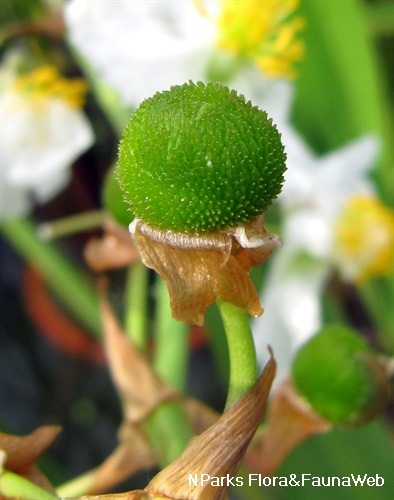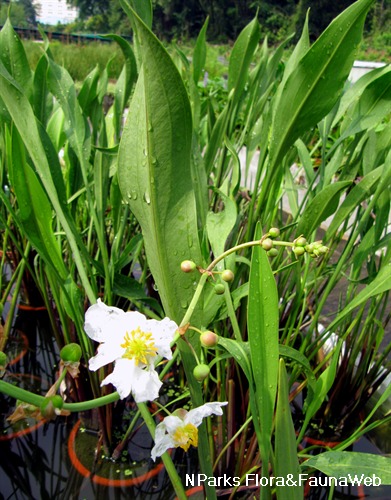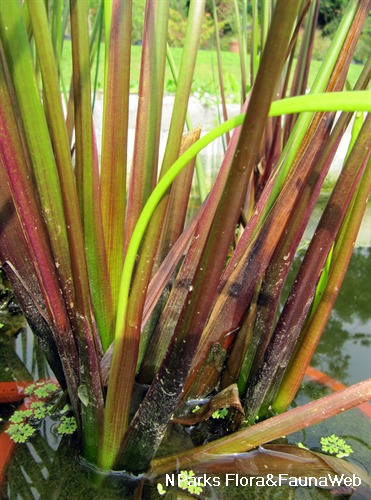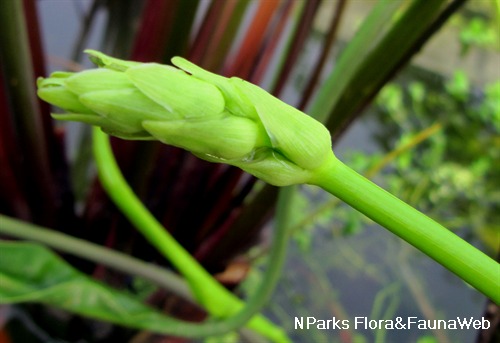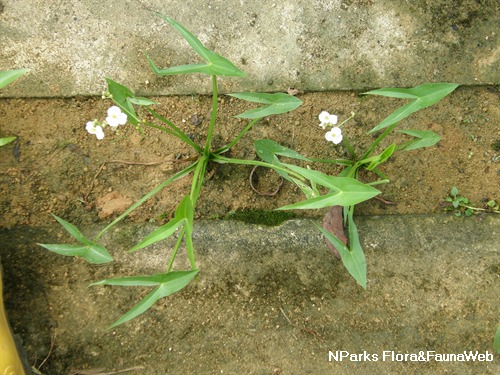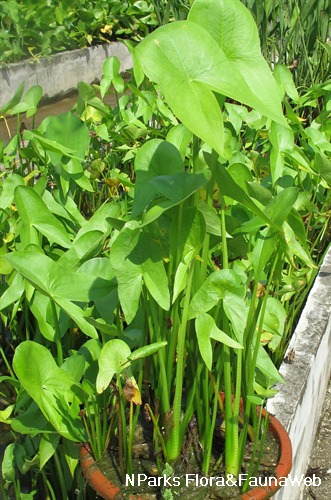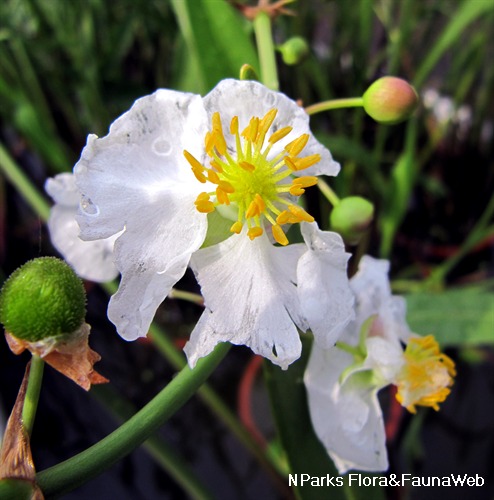
Back
Sagittaria lancifolia L.
| Family Name: | Alismataceae |
| Synonyms: | Sagittaria acutifolia L.f., Sagittaria angustifolia Lindl. |
| Common Name: | Bulltongue arrowhead, Arrow leaf, 野慈姑 |
Name
Classifications and Characteristics
| Plant Division | Angiosperms (Flowering Seed Plants) (Monocotyledon) |
|---|---|
| Plant Growth Form | Aquatic & Hydrophyte (Emergent Aquatic, Waterside / Marginal), Herbaceous Plant |
| Lifespan (in Singapore) | Perennial |
| Mode of Nutrition | Autotrophic |
Biogeography
| Native Distribution | North America and Europe |
|---|---|
| Native Habitat | Terrestrial, Aquatic (Freshwater Pond / Lake / River) |
| Preferred Climate Zone | Tropical, Sub-Tropical / Monsoonal |
Description and Ethnobotany
| Growth Form | Aquatic herbs arising from rhizomes reaching to about 1.5 m tall (maximum height of 2 m) that live in marshes or along river edges. |
|---|---|
| Roots | Rhizomes are coarse and produce tuber. |
| Foliage | Emersed leaves are lance –shaped, basal, long-petiolate (44 – 58 cm). Leaf blades ranged from linear to ovate or elliptic, about 0.7– 16 cm wide with a thick mid rib. Leaf morphology and length vary with amount of phosphorous level in the soil, hence acting as potential indicator of nutrients limitation. |
| Flowers | Emersed inflorescence is raceme and has 6 to 13 whorls with white flowers in whorls of 3. Each flower is 3.3 cm wide. There are 3 sepals which are recurved to spreading in staminate flowers; not enclosing flower or fruit head. Bracts are lanceolate to ovate-lanceolate, acute to acuminate at the apex and ranged from 0.5 to 1 inch. |
| Fruit | Brown obovoid to oval achenes about 1.5 to 2.7 mm long, 1.22 mm wide; are flat, beaked, and winged. Achenes have a grooved surface which increases its surface area in contact with water, thus increasing their floatability. |
| Etymology | Sagittaria refers to the leaf-blade of the plant, which is shaped like the point of an arrow. lancifolia come from the Latin word "lancifolius" meaning to have leaves shaped like a lance-head. |
| Ethnobotanical Uses | Edible Plant Parts : Edible Roots Food (Fruit or Vegetable): The root can be eaten raw or cooked and tasted like sweet chestnut when roasted. The tuber can be dried and ground into a powder and used to make bread. Medicinal: The roots are used as a digestive and treatment of wounds and sores. |
Landscaping Features
| Desirable Plant Features | Ornamental Flowers, Ornamental Foliage |
|---|---|
| Landscape Uses | Parks & Gardens, Riverine, Pond / Lake / River |
| Thematic Landscaping | Water Garden |
Fauna, Pollination and Dispersal
| Fauna Pollination Dispersal Associated Fauna | Bird-Attracting |
|---|---|
| Pollination Method(s) | Biotic (Fauna) (Insects (Butterfly, Moth), Insects (Bee)) |
| Seed or Spore Dispersal | Abiotic |
Plant Care and Propagation
| Light Preference | Full Sun |
|---|---|
| Water Preference | Lots of Water |
| Plant Growth Rate | Fast |
| Rootzone Tolerance | Moist Soils, Waterlogged Soils, Heavy Clay Soils, Acidic (low pH) Soils, Alkaline high pH Soils |
| Propagation Method | Seed, Storage Organ (Root Tuber), Division |
Foliar
| Foliage Retention | Evergreen |
|---|---|
| Mature Foliage Colour(s) | Green |
| Mature Foliage Texture(s) | Smooth |
| Foliar Type | Simple / Unifoliate |
Floral (Angiosperm)
| Flower Colour(s) | White, Yellow / Golden |
|---|---|
| Flower Grouping | Cluster / Inflorescence |
| Flower Location | Terminal |
| Inflorescence Type | Raceme, Panicle |
| Flower Lifespan on Plant | 1 Day |
Fruit, Seed and Spore
| Mature Fruit Colour(s) | Green |
|---|---|
| Mature Seed Colour(s) | Brown |
Image Repository
Others
| Master ID | 31324 |
|---|---|
| Species ID | 5721 |
| Flora Disclaimer | The information in this website has been compiled from reliable sources, such as reference works on medicinal plants. It is not a substitute for medical advice or treatment and NParks does not purport to provide any medical advice. Readers should always consult his/her physician before using or consuming a plant for medicinal purposes. |

